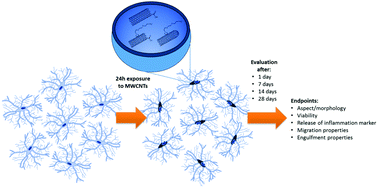当前位置:
X-MOL 学术
›
Nanoscale Horiz.
›
论文详情
Our official English website, www.x-mol.net, welcomes your feedback! (Note: you will need to create a separate account there.)
Primary microglia maintain their capacity to function despite internalisation and intracellular loading with carbon nanotubes†
Nanoscale Horizons ( IF 9.7 ) Pub Date : 2017-06-15 00:00:00 , DOI: 10.1039/c7nh00055c Cyrill Bussy 1, 2, 3, 4, 5 , Alberto Bianco 6, 7, 8, 9, 10 , Maurizio Prato 11, 12, 13, 14, 15 , Kostas Kostarelos 1, 2, 3, 4, 5
Nanoscale Horizons ( IF 9.7 ) Pub Date : 2017-06-15 00:00:00 , DOI: 10.1039/c7nh00055c Cyrill Bussy 1, 2, 3, 4, 5 , Alberto Bianco 6, 7, 8, 9, 10 , Maurizio Prato 11, 12, 13, 14, 15 , Kostas Kostarelos 1, 2, 3, 4, 5
Affiliation

|
Biomedical applications of functionalised carbon nanotubes (f-CNTs) for imaging as well as drug or gene delivery in the brain have recently gained interest. Several studies have demonstrated the potential of f-CNTs to offer treatment options for neurological conditions with success. However, there is also evidence that f-CNTs accumulate preferentially within microglial cells when introduced in the brain. Considering the key immunological role of these cells in the brain and the limited knowledge regarding the interaction of CNTs with microglial cells, it is imperative to understand whether accumulation of CNTs in microglial cells can alter their physiological functions or trigger pro-inflammatory signalling. The aim of the present study was to investigate the basic physiological functions of isolated primary microglial cells over time, following their exposure to multi-walled carbon nanotubes functionalized via different surface chemistries. We rationalized that some chemical strategies may be more deleterious for microglial cell functions than others. We used rat primary microglial cells that can be maintained in cell culture for a long period of time without undergoing cell division. Cell viability, phagocytosis, migration, and pro-inflammatory factor release were studied over one month, following a single exposure to a non-cytotoxic concentration of three different f-CNTs (carboxylated, aminated and both carboxylated and aminated). We show that f-CNTs do not induce inflammation and do not affect the basic functions of microglial cells under these conditions. Importantly, this was the case from day 1 to day 28 post-exposure, even though microglial cells had internalized f-CNTs in subcellular compartments and retained the nanotube load in their cytoplasm over time.
中文翻译:

尽管内在化和碳纳米管在细胞内负载,初级小胶质细胞仍保持其功能†
功能化碳纳米管(f-CNT)在成像以及在大脑中的药物或基因传递方面的生物医学应用近来引起了人们的兴趣。多项研究表明,f-CNTs具有成功为神经系统疾病提供治疗选择的潜力。但是,也有证据表明,将f-CNT引入大脑后,它们会优先在小胶质细胞内积聚。考虑到这些细胞在大脑中的关键免疫学作用以及关于CNT与小胶质细胞相互作用的知识有限,必须了解CNT在小胶质细胞中的积累是否会改变其生理功能或触发促炎性信号传导。本研究的目的是研究随时间推移分离的原代小胶质细胞的基本生理功能,通过不同的表面化学。我们认为,某些化学策略对小胶质细胞功能的危害可能大于其他策略。我们使用的大鼠原代小胶质细胞可以在细胞培养物中长期维持,而不会发生细胞分裂。在单次暴露于非细胞毒性浓度的三种不同的f-CNT(羧化,胺化以及羧化和胺化)后,研究了细胞生存力,吞噬作用,迁移和促炎因子释放,历时一个月。我们表明,在这些情况下,f-CNTs不会诱导炎症并且不会影响小胶质细胞的基本功能。重要的是,从暴露后第1天到第28天就是这种情况,
更新日期:2017-06-15
中文翻译:

尽管内在化和碳纳米管在细胞内负载,初级小胶质细胞仍保持其功能†
功能化碳纳米管(f-CNT)在成像以及在大脑中的药物或基因传递方面的生物医学应用近来引起了人们的兴趣。多项研究表明,f-CNTs具有成功为神经系统疾病提供治疗选择的潜力。但是,也有证据表明,将f-CNT引入大脑后,它们会优先在小胶质细胞内积聚。考虑到这些细胞在大脑中的关键免疫学作用以及关于CNT与小胶质细胞相互作用的知识有限,必须了解CNT在小胶质细胞中的积累是否会改变其生理功能或触发促炎性信号传导。本研究的目的是研究随时间推移分离的原代小胶质细胞的基本生理功能,通过不同的表面化学。我们认为,某些化学策略对小胶质细胞功能的危害可能大于其他策略。我们使用的大鼠原代小胶质细胞可以在细胞培养物中长期维持,而不会发生细胞分裂。在单次暴露于非细胞毒性浓度的三种不同的f-CNT(羧化,胺化以及羧化和胺化)后,研究了细胞生存力,吞噬作用,迁移和促炎因子释放,历时一个月。我们表明,在这些情况下,f-CNTs不会诱导炎症并且不会影响小胶质细胞的基本功能。重要的是,从暴露后第1天到第28天就是这种情况,


























 京公网安备 11010802027423号
京公网安备 11010802027423号